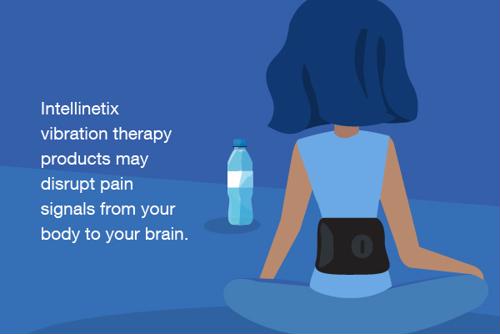
Intellinetix vibration therapy products may disrupt pain signals from your body to your brain.
The common phrase "no pain, no gain" has always been used as a method of motivation for exercise. When you feel the burn, you know it's working and you'll see results. Many can relate to the day of soreness after training a certain muscle group – that feeling of barely being able to move after spending a few hours at the gym the day before. While this feeling may be familiar, it's actually more serious than you think and it's referred to as Delayed Onset Muscle Soreness.
What is Delayed Onset Muscle Soreness?
While you exercise, you alter, stretch and swell your muscles. Essentially, you completely break down the tissue so that it can rebuild itself to grow stronger. DOMS is the reaction to this, according to Pete McCall, an exercise physiologist and ACE-certified personal trainer.
"The very easy explanation is that you break muscle fibers down during exercise, and then your body builds them back up while healing, causing inflammation," McCall told Women's Health magazine. "Soreness is a response to damaged individual muscle fibers."
Symptoms of DOMS
Beyond the obvious pain that comes with DOMS, Ultra Running magazine reported some of the other common symptoms one may experience. Those include:
- Tenderness of the muscles.
- Stiffness of the muscles and joints.
- Swelling in the affected area.
- Loss of strength.
- Limited range of motion.
These symptoms can appear anywhere between 24 and 48 hours after working a specific muscle group, and last up to seven days. If pain lasts longer than a week, you may consider seeking help from a medical professional.
Treating DOMS
Instead of waiting for the pain to subside, there are numerous ways to relieve the discomfort that comes with DOMS. Consider the following:
- Take a break from exercise. Don't damage your muscles more! Take a day or two off from the gym if you're experiencing severe soreness.
- Try yoga. Take a load off and work on perfecting your stretching in the art of yoga. Just don't flex too aggressively – be gentle as you pose.
- Stay hydrated. According to Lance Dalleck, Ph.D., assistant professor of exercise science at Western State Colorado University, nutritional intervention may be your ticket to relief. He told Men's Journal that antioxidants in fruits like pomegranates and blueberries have been shown to reduce inflammation and improve recovery times.
- Use vibration therapy: Another way to relax your muscles and mitigate the pain is through vibration therapy. It uses gentle vibrations to contract and relax the muscles, which increases blood flow to the affected areas. The vibration may disrupt pain signals from your body to your brain and replace them with a calming, massaging sensation.
If you're interested in trying vibration therapy for DOMS, consider Intellinetix wearable vibration therapy products. These products let you easily target the source of pain, providing relief to any sore areas, including your hands, back, shoulders, knees, elbows and shins.
Learn how you can get your hands on Intellinetix products today.
